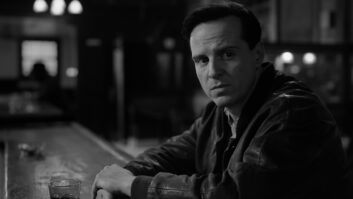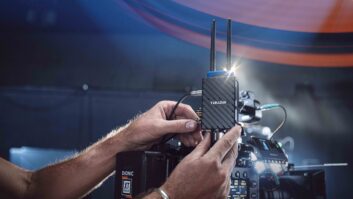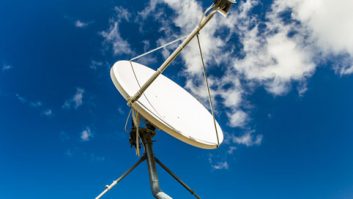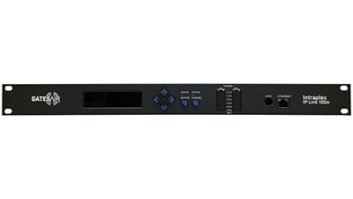One of the biggest changes to the UK’s broadcast audio industry in recent years has been Ofcom’s 700MHz clearance programme. First announced in 2012, the project finally reached completion in the summer of 2020, 18 months earlier than originally proposed.
Ofcom cleared 700MHz to make way for 5G, which is great for remote production, but meant major changes for the audio industry, particularly around RF equipment used by the PMSE community for live production.
One of the companies at the forefront of developing new technology to enable broadcasters to use 960MHz is Terry Tew Sound and Light. The loss of the 700MHz spectrum meant the company had to completely refresh its radio mic stock, over 500 channels.

Managing director Terry Tew and RF and broadcast coordinator Jonathan Edwards are involved in a number of industry steering groups and working groups with the aim of resolving issues brought about by spectrum sell-offs, including the DTG’s PMSE Working Group which works alongside Ofcom. “We’ve had optics on both the 700 and 800MHz sell-offs for many years, and we consulted on and monitored them both very closely,” explains Edwards. “I also sit on the steering committee of an organisation called BEIRG (British Entertainment Industry Radio Group) which is a not-for-profit organisation that works for the benefit of PMSE users, and who’s work within the PMSE community has been well recognised since its inception in 2004.
“The aim of both of those groups is to work in harmony with Ofcom, not against them. Which has led to the PMSE community gaining access to the 960MHz band, commonly known as the DME band.”
Moving the UK’s broadcast industry to 960MHz was no mean feat, not least because the technology for the spectrum had yet to be developed. In 2017 the R&D team at Terry Tew began holding discussions with various manufacturers about possible new products. “The DME band was only being opened up in the UK, so manufacturers were reluctant to develop new technology because the market was deemed too small,” explains Edwards. “However, Wisycom saw it as an opportunity and accepted the challenge. Terry and I worked for many months with their R&D department and MD, Massimo Polo, directly. The focus was on producing a series of products suitable for the UK market, that covered the new split band spectrum that the telecommunication services now have access to. We wanted to really turn some heads and show the other reluctant manufacturers that there was scope for some really pioneering engineering and progression.”
Both companies, alongside Wisycom’s UK distributor Raycom, spent three years developing a viable product that they could take to Terry Tew’s clients. “It’s been a major overhaul of our inventory,” admits Edwards. “Every radio mic we had was swapped out. There were so many other variables that needed thinking about too. One obvious thing that we were very conscious of was that the telecommunication networks would be transmitting in a portion of spectrum that the PMSE industry once had, and our antennas were susceptible to that.”
Together with Wisycom, the team at Terry Tew developed a built-in filter that makes the antenna blind to 5G, 4G and 3G frequencies. “You can go from the bottom of the UHF spectrum, but we start at 510MHz, leaving space between us and the comms world, all the way up to 698MHz.
Then there’s the notch filter which opens again at 960MHz and covers the DME band.
“Within that notch filter are all the 3G/4G/5G signals, and the antenna is completely blind to them,” explains Edwards. “That didn’t exist before we did the R&D and it’s been a massive game changer.
“The other product that was needed in order to make 960MHz work in harmony with the remaining UHF spectrum were Antenna Distribution Units,” he continues. “There wasn’t an off the shelf solution that fitted our brief. So again, we turned inward and made an in-house solution. Raycom developed an RF board, again incorporating our notch filter idea giving us double the protection. Once the board had gone through various third-party test houses, we designed and built our own bespoke ADU’s and added features like Dante, network connectivity and dual redundant power supplies, the latter being a feature that’s requested more and more by broadcasters. The ADU’s have changed the workflow of many audio departments on shows like The Voice and Strictly Come Dancing.”
‘’We completely rely on RF to make TV shows’’ adds Andy Tapley, Sound Supervisor at BBC Studioworks. ‘’Strictly for instance uses in excess of 60 radio mics – when you think of 15 couples at the start off the series that’s 30 radio mics for them, plus the judges, presenters, guests, music acts that come in, and that’s just one studio on a multi-studio site. So, the whole frequency management has to be incredibly carefully planned.”
After working with the team at Terry Tew, Studioworks first moved into the 960MHz band in 2020. “It’s taken a lot of effort to get there because, as you can imagine, selling off that spectrum has presented huge challenges for our rental suppliers,” admits Tapley, “but we now feel in a safe place thanks to their hard work’’.
“It was a massive learning curve for all parties involved,” agrees Edwards. “It’s all very well being in the office playing with prototypes and thinking it’s brilliant, but when it’s out on a show it needs to be solid and reliable because you’re only as good as your last show. We took a leap of faith and Wisycom have been remarkable. They have accommodated, listened, and reacted in a timely manner. The answer is never an outright ‘no’, it’s a ‘leave it with us’. To this day there’s that constant communication between the three companies developing new technology.”







